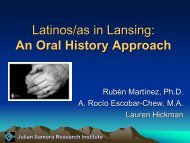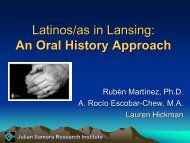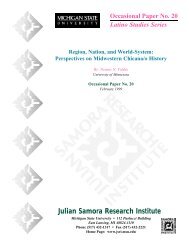Guanajuatense and Other Mexican Immigrants in the United States ...
Guanajuatense and Other Mexican Immigrants in the United States ...
Guanajuatense and Other Mexican Immigrants in the United States ...
Create successful ePaper yourself
Turn your PDF publications into a flip-book with our unique Google optimized e-Paper software.
A grow<strong>in</strong>g number of <strong>Mexican</strong> newcomers have settled<strong>in</strong> U.S. non-metropolitan areas <strong>and</strong> work <strong>in</strong> agricultural<strong>in</strong>dustries. The non-metropolitan Lat<strong>in</strong>o populationgrew from 1.8 million to 2.4 million between 1980 <strong>and</strong>1990, an <strong>in</strong>crease of 30% (Rochín <strong>and</strong> Marroqu<strong>in</strong>, 1997).The immigrants among <strong>the</strong>ir ranks grew from 37.9% to39.1% (Rochín <strong>and</strong> Marroqu<strong>in</strong>, 1997). 10 An estimatedone million <strong>Mexican</strong>s live <strong>in</strong> metropolitan areas, wherehous<strong>in</strong>g is available, but <strong>the</strong>y work <strong>in</strong> traditional nonmetropolitan<strong>in</strong>dustries, such as agriculture <strong>and</strong> food-process<strong>in</strong>gplants (Rochín <strong>and</strong> Marroqu<strong>in</strong>, 1997). <strong>Mexican</strong>s<strong>and</strong> Chicanos live with<strong>in</strong> <strong>the</strong> metropolitan areas of Fresno<strong>and</strong> Sacramento, Calif., but harvest tomatoes, cucumbers,<strong>and</strong> many o<strong>the</strong>r crops grown <strong>in</strong> surround<strong>in</strong>g farml<strong>and</strong>.The same residence <strong>and</strong> employment pattern can befound <strong>in</strong> o<strong>the</strong>r parts of <strong>the</strong> country. <strong>Mexican</strong> immigrants<strong>and</strong> migrants live <strong>in</strong> Omaha, Neb., <strong>and</strong> Newark, Del., <strong>and</strong>work <strong>in</strong> surround<strong>in</strong>g meat process<strong>in</strong>g-plants (Gouveia,forthcom<strong>in</strong>g; Horowitz <strong>and</strong> Miller, forthcom<strong>in</strong>g).Additionally, <strong>the</strong> <strong>in</strong>creas<strong>in</strong>g <strong>Mexican</strong> population <strong>in</strong>non-metropolitan areas <strong>and</strong> metropolitan centers <strong>in</strong> majoragricultural regions is reflected by <strong>the</strong> grow<strong>in</strong>g number offarmworkers. It is estimated that <strong>the</strong> farmworker population<strong>in</strong> <strong>the</strong> <strong>United</strong> <strong>States</strong>, <strong>the</strong> majority of whom are of<strong>Mexican</strong> descent, <strong>in</strong>creased from 1.8 to 2.5 million from1960 to 1996 (Greenhouse, 1998). Given <strong>the</strong> Bureau of<strong>the</strong> Census’ shortcom<strong>in</strong>gs <strong>in</strong> enumerat<strong>in</strong>g migratoryfarmworkers, especially transnational migrants [migrantswhose permanent base is <strong>in</strong> a country o<strong>the</strong>r than <strong>the</strong><strong>United</strong> <strong>States</strong>], <strong>the</strong> growth of <strong>the</strong> farmworker populacemay be higher than <strong>in</strong>dicated <strong>in</strong> <strong>the</strong> census figures (García<strong>and</strong> González, 1995; Palerm, 1995). The mobility,hous<strong>in</strong>g <strong>and</strong> residence practices, <strong>and</strong> limited knowledgeof <strong>the</strong> English language of <strong>the</strong> migrants make <strong>the</strong>m difficultto locate <strong>and</strong> enumerate (García <strong>and</strong> González, 1995;Palerm, 1995).The <strong>in</strong>crease <strong>in</strong> <strong>the</strong> farmworker population hascaught many so-called experts by surprise. A couple ofdecades ago, dur<strong>in</strong>g <strong>the</strong> height of research at l<strong>and</strong>-grantuniversities on mechaniz<strong>in</strong>g harvests, agricultural economistspredicted <strong>the</strong> decl<strong>in</strong>e <strong>and</strong> possible elim<strong>in</strong>ation oflaborers <strong>in</strong> <strong>the</strong> harvest process of many vegetables <strong>and</strong>fruits (Palerm, 1991). Instead, as Palerm (1991), García<strong>and</strong> González (1995), <strong>and</strong> Griffith <strong>and</strong> Kissam (1995)have found <strong>in</strong> <strong>the</strong>ir research, <strong>the</strong> opposite has occurred <strong>in</strong>California, Pennsylvania, Florida, <strong>and</strong> o<strong>the</strong>r states.Today, <strong>the</strong>re are more farmworkers <strong>in</strong> <strong>the</strong>se states thanever before.<strong>Mexican</strong> EnclavesIn <strong>and</strong> out of non-metropolitan areas across <strong>the</strong>nation, <strong>Mexican</strong> immigrants are settl<strong>in</strong>g <strong>in</strong> communitiesnear labor-<strong>in</strong>tensive agriculture <strong>and</strong> food-process<strong>in</strong>gplants. They are creat<strong>in</strong>g enclaves – a grow<strong>in</strong>g concentrationof foreign- <strong>and</strong> U.S.-born <strong>Mexican</strong> residents – thatdid not have a settled <strong>Mexican</strong> population <strong>in</strong> <strong>the</strong> past.This population is chang<strong>in</strong>g <strong>the</strong> demographic characteristicsof local neighborhoods, from predom<strong>in</strong>antly ag<strong>in</strong>g<strong>and</strong> Anglo to young <strong>and</strong> <strong>Mexican</strong>. At <strong>the</strong> same time,<strong>Mexican</strong> populace is alter<strong>in</strong>g <strong>the</strong> local culture, by <strong>in</strong>troduc<strong>in</strong>g<strong>the</strong> Spanish language, sett<strong>in</strong>g up ano<strong>the</strong>r way oflife, <strong>and</strong> establish<strong>in</strong>g traditional <strong>Mexican</strong> practices, suchas t<strong>and</strong>as [rotat<strong>in</strong>g credit associations] <strong>and</strong> compadrazgo[fictive k<strong>in</strong>] ties.In Pennsylvania, <strong>the</strong> authors (García <strong>and</strong> González,1995) <strong>Mexican</strong> enclaves are emerg<strong>in</strong>g <strong>and</strong> <strong>the</strong>ir populationsare grow<strong>in</strong>g <strong>in</strong> many counties, such as Burks <strong>and</strong>Chester, that until two decades ago did not attract <strong>Mexican</strong>immigrants <strong>and</strong> migrants <strong>in</strong> large numbers. In <strong>the</strong>1990 census, 232,000 Lat<strong>in</strong>os were enumerated <strong>in</strong> Pennsylvania.If <strong>the</strong> thous<strong>and</strong>s of transnational <strong>Mexican</strong>migrants who live <strong>in</strong> relatively hidden labor camps were<strong>in</strong>cluded <strong>in</strong> <strong>the</strong> census, this number would be higher. In<strong>the</strong> census, Puerto Ricans made up <strong>the</strong> majority of <strong>the</strong>Lat<strong>in</strong>os at 65%, while <strong>the</strong> <strong>Mexican</strong>s were <strong>the</strong> secondlargest constituency group at 10.2%. The majority of <strong>the</strong>Puerto Ricans live <strong>in</strong> cities on <strong>the</strong> eastern side of <strong>the</strong> state(Falcon, 1993), while <strong>the</strong> <strong>Mexican</strong>s are concentrated <strong>in</strong>townships <strong>and</strong> boroughs outside of <strong>the</strong>se metropolitanareas <strong>in</strong> vegetable, fruit, <strong>and</strong> mushroom-produc<strong>in</strong>gregions (García, 1997).Enclaves <strong>in</strong> Sou<strong>the</strong>rn ChesterCounty, PennsylvaniaThe largest concentration of <strong>Mexican</strong> immigrants <strong>and</strong>migrants <strong>in</strong> Pennsylvania are found <strong>in</strong> Sou<strong>the</strong>rn ChesterCounty (see Map 2), a semi-rural <strong>and</strong> major mushroomproduc<strong>in</strong>gregion <strong>in</strong> <strong>the</strong> country. Sou<strong>the</strong>rn ChesterCounty is comprised of four boroughs <strong>and</strong> 19 townships<strong>in</strong> 18 municipalities. 11 The communities are small, withunder 10,000 <strong>in</strong>habitants, <strong>and</strong> situated along <strong>the</strong> old BaltimorePike, Route One. Interspersed around <strong>the</strong>m aremushroom houses, migrant labor camps, <strong>and</strong> horseranches. In <strong>the</strong> communities, <strong>Mexican</strong> workers <strong>and</strong> <strong>the</strong>irfamilies, ma<strong>in</strong>ly from Guanajuato, are creat<strong>in</strong>g enclaves.Two examples are found <strong>in</strong> Kennett Square <strong>and</strong> Toughkenamon(see Map 2).3







